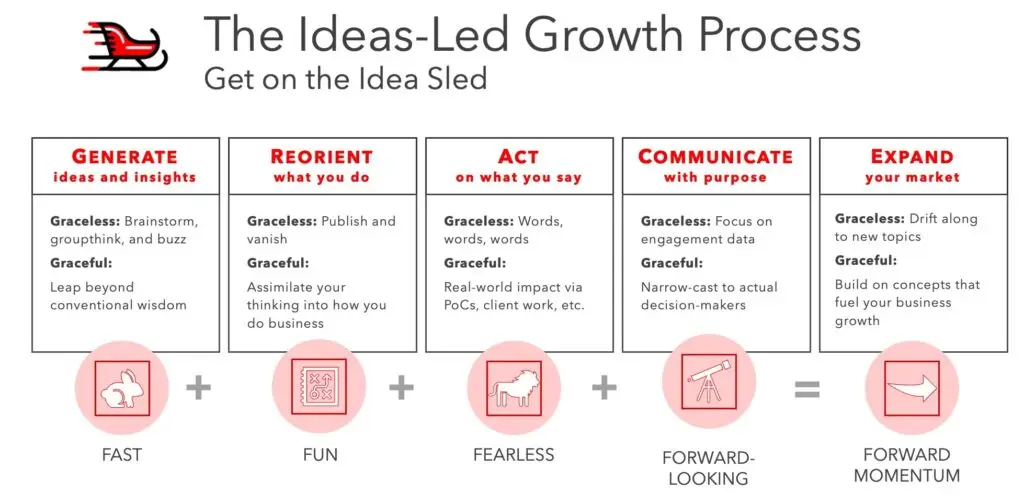Thought leadership should be fun, fast, and fearless. You tap into excitement about new ideas and advocate for something better. That’s the mindset behind The Idea Sled. Projects glide forward gracefully. It’s the momentum of commitment. This newsletter shows you how.
Click-bait represents the unintentional gold standard of the content-industrial complex. As thinkers and doers with ideas, we should make every effort to oppose it. The alternative is idea-bait. It offers ideas that entice and thoughts that lead. In other words, it’s thought leadership.
This pivot matters because thought leadership should only exist to influence and enable decisions. In markets flooded with metrics-chasing campaigns, idea-bait principles make your ideas precise, relevant, and powerful enough to reshape an executive’s next move. They help teams stay faithful to strategic insight even when generic content-marketing advice pushes you toward safer, shallower tactics. They may even change how your entire industry thinks.
This is a manifesto for crossing the threshold into the Idea-Bait Era. The time is now to break the spell of the content mentality. Claim the advantage that belongs to those who publish ideas with purpose.
The Foundation
- Ideas that aren’t bold enough to shift decisions and move mountains don’t deserve communication. They merely create noise masquerading as signal.”
- We measure thought leadership value by minds changed, not metrics gamed.
- Ideas are not democratic. The best thinking comes from the few who have done the hardest work. We protect the signal from the noise of consensus.
The Power Structure
- Strategy speaks whether we say it aloud or not. Every roadmap, every backlog, every release broadcasts what we believe. When we leave these signals unvoiced, others can take our narrative or redefine the field. When we communicate those beliefs clearly, we guide expectations, invite the right partners, and sharpen internal execution.
- We will not surrender ideas to content-industrial practices and mindsets. Marketing produces and amplifies. Strategy originates. When we reverse this order, differentiation dies and tactics reign. The power to shape thought belongs first to those who generate ideas worth shaping.
- Ideas demand champions, not handlers. The critical role of a thinking partner is to refine and amplify our convictions, not sand them smooth. The return on this partnership dwarfs every hour invested. Those who attempt to co-opt ideas in isolation drain them of their full power.
- We partner with those who see what we might overlook, not those who mirror our biases. A true thinking partner understands our market dynamics and pushes us to think and communicate with more rigor.
The Hard Realities
- We reject the bland safety of groupthink and writing by committee. Thought leadership beaten into shape by endless feedback and approvals ends up voiceless. It doesn’t matter what it says if it doesn’t have a voice to hear or read.
- Hesitation is expensive. Leaders overestimate the effort required to plan and create thought leadership and underestimate the cost of invisibility. They may have been burned before. While they resist, inferior ideas capture mindshare.
- Compliance protects against legal risk. Thought leadership protects against strategic stagnation by standing for a clear point of view.
- The greater risk is not controversy but invisibility. Irrelevance is permanent. Controversy passes.
- Ideas multiply when published and die when hoarded or roadblocked by unnecessary process.
The Method
- Experience is the only credential that matters. The credibility of a perspective shows up in our wins and our scars. Especially with AI, anyone can mimic an informed opinion. But nothing replaces the value of decisions made under pressure. We share not just what we know but how we came to know it.
Imagine that a payment platform firm issues a two-page brief on the hidden cost of stale funds availability. The memo reframes the delay as a balance-sheet liability. Within days, several treasurers flag it to justify piloting instant-payment rails. A small, clear idea leads to real budget and implementation.
- There is no neutral tone. Every sentence positions you. Neutrality is an illusion. Precision is power.
- Problems drive publication, not calendars. Authentic urgency cannot be scheduled.
- The conversations that matter usually happen outside thought leadership brainstorms. They emerge in hallway chats, Slack threads, client meetings, and project retrospectives. Capture them, distill the strategic intent behind them, and shape them into differentiated theses.
What you can do: Call a 30-minute huddle with a small client-facing team. Ask one question: What did clients struggle to articulate last quarter? What unexpected questions did they ask you? Capture answers, choose the richest one, craft a hypothesis, draft a paragraph. This process initiates your next campaign.
- Complexity demands interpretation. Those who translate chaos into clarity claim authority over both.
- Surface the questions your clients sense but cannot phrase, and you become indispensable.
What you can do: Sketch a two-column grid: left, the decision senior buyers must make; right, the friction they feel. One sentence per row. Those rows become sub-heads, the frictions your supporting points. Your outline now mirrors how executives weigh risk and can seed a thought leadership piece.

The Approach
- Form serves conviction. Whether an article, report, whitepaper, webinar, panel, or conversation, the medium that best conveys our convictions to decision-makers is the right one to choose.
- Context is the new currency. We share not just our conclusions but the journey that led us there. The reasoning matters as much as the result.
- Strategic questions reveal more than strategic answers. The executive who openly wrestles with uncertainty demonstrates strength. We model this courage.
- Published principles align execution faster than endless meetings. When we declare what we stand for, internal friction vanishes, and external allies self-select.
The Market
- We join the conversations already happening in corner offices and start new ones. We earn our place at those tables by offering clarity that executives crave but cannot create alone.
- Thought leadership is not broadcast to the entire market; it is a signal tuned to the executives already scanning for clarity on emerging pressure points. When they recognize their own dilemmas in your framing, trust forms instantly. Others may glance and move on. By writing for the decisive minority, you accelerate conversations that lead to partnership, product fit, and industry shifts. Depth and precision drive momentum.
- Markets reward clear idea signals from practitioners who have done the work and speak candidly.
- Every insight you publish multiplies its value in the market. Left unpublished, thinking remains a private cost.
- Consistency builds recognition. Traction proves relevance. We design for both or achieve neither.
The Stakes
- We care about helping our peers, clients and prospects pause, question, reconsider, and adjust to their next move. Such care is essential when people make high-stakes decisions that can move assets, markets, reputations, and careers.
- Influence occurs when words change behavior.
Picture a data provider circulating a one-page point of view that provides guidance on capturing duration drag in private credit portfolios ahead of a rate move. Syndicate teams absorb the insight, tighten covenant terms in the next deal cycle, and the negotiation baseline shifts. The data provider’s piece proved two things simultaneously: (a) it offers differentiated insight, and (b) those insights move real money. Desks wanting the next signal subscribe to the firm’s full data feed. Thought leadership converts to recurring revenue. - We write to be remembered by those whose memories matter. Impressions make a difference when they are made, not counted. Everyone else is just checking boxes.
The age of safe, committee-approved content and click-bait practices is already over. Now, let the age of idea-bait begin.

Three Grace Notes
“Satisfaction derives not merely from being filled but from being filled with a current that will not cease.”
—Lewis Hyde, The Gift: Creativity and the Artist in the Modern World
“If you think the gift of prophesy has been given you; then, by all means, write your bad poems, your insufferable fictions, enjoy the fame that easy ideas often offer, ride the flatulent winds of change, fly like the latest fad to the nearest dead tree; but do not try to count the seasons of your oblivion.” —William Gass, Life Sentences: Literary Judgments and Accounts
“This quality of rushed busyness expresses in action the absence of vision in thought, the absence of principles that establish coherence and priority.” —Thomas de Zengotita, Mediated: How the Media Shapes Your World and the Way You Live in It
Note: The links above are affiliate links. I’m using them in lieu of paid subscription tiers or digital tip jars. Seems like a much more graceful way to generate financial support while sharing more thinking and writing that can guide thought leadership.




